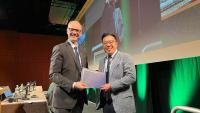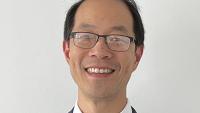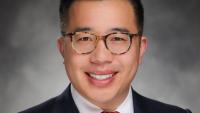Scoliosis
Make an Appointment
Our team of dedicated access representatives is here to help you make an appointment with the specialists that you need.
Scoliosis = a side-to-side curve in the spine. From the Greek word “skoliosis,” meaning “bending” or “crooked”
Director of our Spine Division, Dean Chou, MD explains adult scoliosis types and treatments:
Scoliosis is an abnormal curvature of the spine.
When viewed from behind, the typical spine is straight. A side-to-side curve in the spine that measures 10 degrees or more on an X-ray is called scoliosis. Scoliosis has to do with the structure of the spine; it is not the same as poor posture.
Symptoms
Scoliosis has many possible causes, and its symptoms can vary by cause.
Congenital scoliosis, which is due to a defect present at birth, can rarely produce weakness, numbness, or clumsiness if it affects the spinal cord.
Idiopathic scoliosis, which develops for no known cause, does not usually cause pain or other troublesome symptoms but can cause noticeable postural changes.
Degenerative scoliosis, which results from wear and tear on the discs and joints of the spine, is likely to cause symptoms. Symptoms of degenerative scoliosis may include:
- Back pain that is worse with sitting or standing and that usually goes away when lying down
- Electric shock-like pain
- Numbness
- Weakness in one or both legs
Scoliosis produced by muscle spasm is generally painful. Causes of this type of scoliosis include infection or tumor.
Regardless of whether it produces symptoms troublesome to the patient, scoliosis can produce the following outward indications that it is present. (Outward indications that a condition is present are called signs):
- The difference in shoulder height
- Head off-center with the rest of the body
- The difference in hip height or position
- The difference in shoulder blade height or position
- The difference in the way the arms hang beside the body when standing straight
- When bending forward, the difference in height between the sides of the back
Diagnosis
It is common for children to be examined for scoliosis at school screenings. Many cases of scoliosis are detected during these screenings.
To confirm a diagnosis of scoliosis, the doctor may order the following diagnostic procedures to help see the entire spine from the base of the skull to the pelvis:
- X-Ray: provides detailed pictures of bones of the spine. Upright and dynamic (or flexion/extension) X-rays, which show the spine in motion, are the best way to assess the alignment and stability of the spine.
- Magnetic resonance (MR) imaging: a diagnostic procedure that uses a combination of large magnets, radiofrequencies, and a computer to produce detailed images of organs and structures within the body.
- Computed tomography (CT) scan: a diagnostic imaging procedure that uses a combination of X-rays and computer technology to produce detailed images of the body. A CT scan shows detailed images of any part of the body, including the bones, muscles, fat, and organs. CT scans are more detailed than general X-rays.
With these diagnostic procedures, the doctor can measure the degree of spinal curvature.
Risk Factors
Scoliosis is usually described in two ways: by the age at which a person is first affected, and the underlying cause of the curvature. Both factors—age and cause—influence treatment decisions.
Age
- Infantile: Birth to age 3. Infantile scoliosis usually develops within the first six months of life. The curves do not usually cause an infant any pain. Doctors will monitor children with infantile scoliosis and track the changes in their curves. Most infantile scoliosis resolves on its own, especially when the curves are mild. However, in some cases, curves can grow larger, and even become disabling, if they are not treated. Treatment may involve casting, bracing, and/or surgery. Treatment is generally successful.
- Juvenile: Ages 4-10. Juvenile scoliosis is different from infantile and adolescent scoliosis, because it arises at a time when the spine is not growing rapidly. It is more likely than the other two types to worsen over time, and very unlikely to resolve on its own. Treatment is often required. As with infantile scoliosis, treatment may involve casting, bracing, and/or surgery, and treatment is generally successful.
- Adolescent: Ages 11-18. Adolescent scoliosis is the most common type of scoliosis, and it has the best outlook. That is, the spinal curves in this group are least likely to progress and become troublesome. Each case must be evaluated independently, though: larger curves are more likely to progress, and adolescents with a lot of growing left to do are more likely to have their curves progress as they grow. Most adolescents do not experience pain from their curves. The exceptions are curves that progress quickly—these may cause pain. Treatment may involve bracing to try to halt the progression of moderate curves or surgery to correct severe curves.
- Adult: Older than 18. In adults, scoliosis may be the result of an untreated evolution of one of the types above (adult idiopathic scoliosis) or the result of a degenerative condition.
Cause:
- Idiopathic: This is the most common type in infants, juveniles, and adolescents. “Idiopathic” is a medical term meaning “for a cause that is not known.” Of course, there is a cause—may be more than one–it is simply not understood yet. Adolescent idiopathic scoliosis is the most common type of scoliosis overall.
- Degenerative: This is the most common type of scoliosis in adults. “Degenerative” means “due to wear-and-tear.” This type of scoliosis is due to wear and tear on spinal discs and spinal joints called facet joints. The pain that is sometimes associated with this condition is not due to the curve itself, but to the degeneration of the spine. The goal of treatment is not to slow the curvature since curve progression is slow anyway. Instead, the goal of treatment is to relieve the patient’s symptoms. Although it more often affects the lumbar spine (lower back), it can also affect the thoracic spine (upper back).
- Congenital: “Congenital” means “present at birth.” Congenital scoliosis is usually caused by abnormal development of the bones of the spine, and it occurs in 1 in 10,000 newborns. Children with congenital scoliosis often have problems with the kidney, bladder, or heart as well. Treatment depends on the specific problem, the size of the curve, the age of the child at diagnosis, and other factors. Casting and bracing cannot correct the structural problem, but these methods might help slow the development of curves that arise as the body compensates for the congenital curve.
- Nonstructural: Also called functional scoliosis, this is when a structurally normal spine appears curved due to an underlying condition like a difference in leg length, an inflammatory condition, or another condition. This type of scoliosis is generally temporary and is often relieved when the underlying condition is treated.
Other forms of structural scoliosis: A few causes besides idiopathic, degenerative, and congenital can cause structural scoliosis. These include:
- Disease (i.e., neuromuscular, metabolic, connective tissue, or rheumatoid disease)
- Injury
- Infection
- Abnormal growth or tumor
Treatments
Adolescent idiopathic scoliosis:
Nonoperative treatment, including physical therapy, and strengthening and stretching exercises, may be an option for some patients.
If the curvature measures 25 to 40 degrees on an X-ray, the doctor may recommend a brace be worn for a specific period of time. Bracing is generally implemented in hopes of stopping the progression of the curve and preventing deformity. The type of brace and the amount of time spent in the brace will depend on the severity of the condition.
If the curvature measures 50 degrees or more on an X-ray and bracing is not successful, surgery is then considered to correct the spinal deformity.
The surgeon will correct the deformity using a vertebral column resection or another procedure. After the correction, the surgeon may perform fusion and fixation procedures. In a fusion procedure, graft material is placed between vertebrae. The graft material and vertebrae grow together into one solid bone. In a fixation, the surgeon places a rod or rods that hold the spine in the correct position until the instrumented segments fuse as a bone.
Degenerative scoliosis
If degenerative scoliosis has resulted in spinal stenosis, surgery may be required. Spinal stenosis is the narrowing of the spinal canal, which can result in pressure on the spinal cord. In this case, spinal stenosis is usually caused by the development of bone spurs (overgrowth of bone). To make room for the spinal cord, the surgeon may perform a laminectomy to remove the lamina, which is the bone that covers the spinal canal. After the laminectomy, the spinal cord can move better within the spinal canal. In some cases, the surgeon may perform a spinal fusion to ensure the spinal column is stable after surgery. During a spinal fusion, the surgeon may place a bone or bone graft between the vertebrae and allow the bones to fuse (grow together). This procedure is often performed along with a fixation, in which screws and rods are implanted to hold the spine in the correct position until fusion occurs.
Congenital scoliosis
Infants with congenital scoliosis require surgery if the curvature is progressing. Unlike with adolescent idiopathic scoliosis and degenerative scoliosis, the decision to have surgery for congenital scoliosis depends less on the size of the curve than on its cause and expectation of progression.
The decision-making and surgical planning for the treatment of scoliosis are complex. Our surgeons will determine the best treatment for each patient and in each situation.



